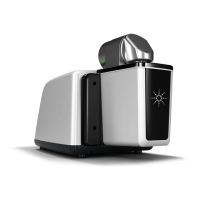Analyzing Samples
26 Agilent Cary 630 FTIR Spectrometer User’s Guide
Diamond ATR Sampling Accessory
The Diamond attenuated total reflectance (ATR) sampling accessory
takes advantage of the physical properties of light when encountering
two materials with differences in index of refraction. When coming in
contact with a sample having a different index of refraction, the
infrared light creates an evanescent wave, which provides a very small
and specific depth of penetration into the sample before reflecting
back into the detector of the spectrometer. This small and consistent
pathlength means no sample preparation is required to get good
measurement results from a variety of samples. The key to obtaining
good results with the Diamond ATR accessory is to make good contact
between the sample and ATR crystal. The ATR technique can be used
for analyzing liquids, pastes, powders and even some solid samples.
The Diamond ATR accessory uses a type IIa diamond crystal as the
interface between the sample and the infrared energy. Advantages of a
diamond crystal are extreme hardness and chemical resistivity, plus it
can accept samples with a pH range from 1 to 14. Therefore, hard or
abrasive samples and even strong acids can be safely analyzed. The
diamond in the Agilent ATR accessory is the world’s most durable
substance and has been designed for maximum infrared signal.
The Diamond ATR is a single-reflection ATR. It is most suitable for
higher absorbing samples such as rubber, polymers, paints and fibers.
Powder and solid samples are also best measured with the single-
reflection ATR, by using the sample press device, which applies high
pressure to powder and solid samples to ensure good contact with the
diamond crystal. The single-reflection ATR is also a good choice when
the amount of available sample is limited. The single-reflection
diamond has a 1 mm diameter sampling surface with 200 μm active
area and provides approximately 2 μm depth of penetration for
infrared energy at 1,700 cm
-1
. The single-reflection ATR protrudes
slightly above the metal mounting plate.
In the sample loading and cleaning mode, the sample press should be
in the highest position, so the sample press tip is well above the
diamond sampling window (see Figure 5). It is in this position that the
sample mounting area can be easily accessed for loading the sample
into place and for cleaning the sampling surfaces before the next
sample is analyzed.

